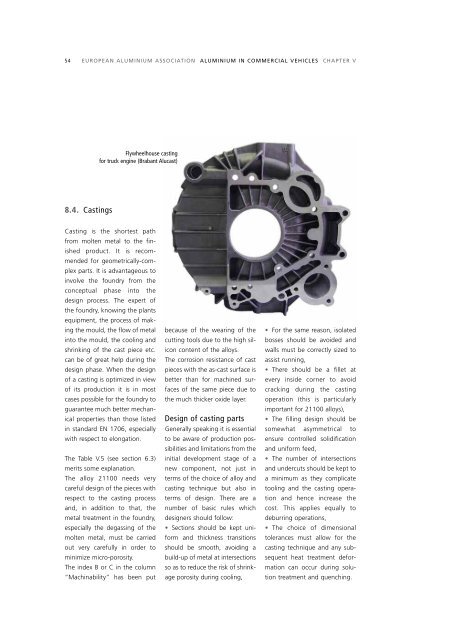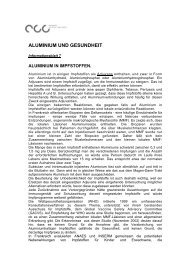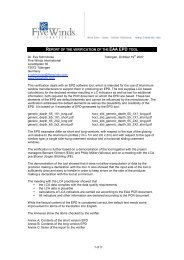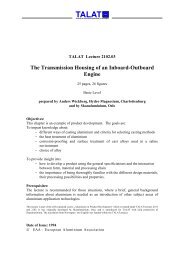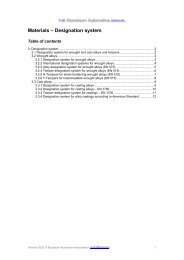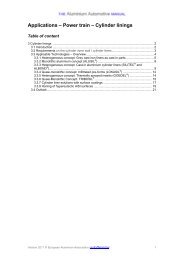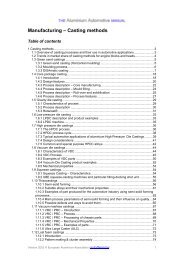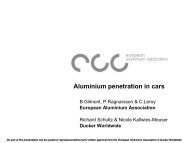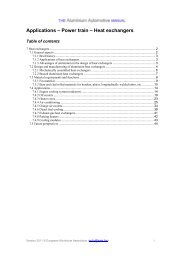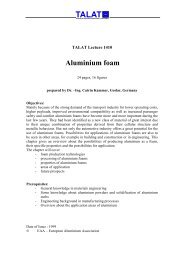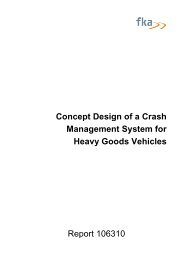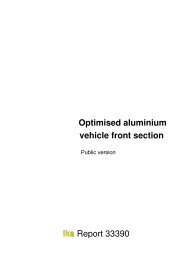aluminium in commercial vehicles - European Aluminium Association
aluminium in commercial vehicles - European Aluminium Association
aluminium in commercial vehicles - European Aluminium Association
You also want an ePaper? Increase the reach of your titles
YUMPU automatically turns print PDFs into web optimized ePapers that Google loves.
54 EUROPEAN ALUMINIUM ASSOCIATION ALUMINIUM IN COMMERCIAL VEHICLES CHAPTER V<br />
8.4. Cast<strong>in</strong>gs<br />
Flywheelhouse cast<strong>in</strong>g<br />
for truck eng<strong>in</strong>e (Brabant Alucast)<br />
Cast<strong>in</strong>g is the shortest path<br />
from molten metal to the f<strong>in</strong>ished<br />
product. It is recommended<br />
for geometrically-complex<br />
parts. It is advantageous to<br />
<strong>in</strong>volve the foundry from the<br />
conceptual phase <strong>in</strong>to the<br />
design process. The expert of<br />
the foundry, know<strong>in</strong>g the plants<br />
equipment, the process of mak<strong>in</strong>g<br />
the mould, the flow of metal<br />
<strong>in</strong>to the mould, the cool<strong>in</strong>g and<br />
shr<strong>in</strong>k<strong>in</strong>g of the cast piece etc.<br />
can be of great help dur<strong>in</strong>g the<br />
design phase. When the design<br />
of a cast<strong>in</strong>g is optimized <strong>in</strong> view<br />
of its production it is <strong>in</strong> most<br />
cases possible for the foundry to<br />
guarantee much better mechanical<br />
properties than those listed<br />
<strong>in</strong> standard EN 1706, especially<br />
with respect to elongation.<br />
The Table V.5 (see section 6.3)<br />
merits some explanation.<br />
The alloy 21100 needs very<br />
careful design of the pieces with<br />
respect to the cast<strong>in</strong>g process<br />
and, <strong>in</strong> addition to that, the<br />
metal treatment <strong>in</strong> the foundry,<br />
especially the degass<strong>in</strong>g of the<br />
molten metal, must be carried<br />
out very carefully <strong>in</strong> order to<br />
m<strong>in</strong>imize micro-porosity.<br />
The <strong>in</strong>dex B or C <strong>in</strong> the column<br />
“Mach<strong>in</strong>ability” has been put<br />
because of the wear<strong>in</strong>g of the<br />
cutt<strong>in</strong>g tools due to the high silicon<br />
content of the alloys.<br />
The corrosion resistance of cast<br />
pieces with the as-cast surface is<br />
better than for mach<strong>in</strong>ed surfaces<br />
of the same piece due to<br />
the much thicker oxide layer.<br />
Design of cast<strong>in</strong>g parts<br />
Generally speak<strong>in</strong>g it is essential<br />
to be aware of production possibilities<br />
and limitations from the<br />
<strong>in</strong>itial development stage of a<br />
new component, not just <strong>in</strong><br />
terms of the choice of alloy and<br />
cast<strong>in</strong>g technique but also <strong>in</strong><br />
terms of design. There are a<br />
number of basic rules which<br />
designers should follow:<br />
• Sections should be kept uniform<br />
and thickness transitions<br />
should be smooth, avoid<strong>in</strong>g a<br />
build-up of metal at <strong>in</strong>tersections<br />
so as to reduce the risk of shr<strong>in</strong>kage<br />
porosity dur<strong>in</strong>g cool<strong>in</strong>g,<br />
• For the same reason, isolated<br />
bosses should be avoided and<br />
walls must be correctly sized to<br />
assist runn<strong>in</strong>g,<br />
• There should be a fillet at<br />
every <strong>in</strong>side corner to avoid<br />
crack<strong>in</strong>g dur<strong>in</strong>g the cast<strong>in</strong>g<br />
operation (this is particularly<br />
important for 21100 alloys),<br />
• The fill<strong>in</strong>g design should be<br />
somewhat asymmetrical to<br />
ensure controlled solidification<br />
and uniform feed,<br />
• The number of <strong>in</strong>tersections<br />
and undercuts should be kept to<br />
a m<strong>in</strong>imum as they complicate<br />
tool<strong>in</strong>g and the cast<strong>in</strong>g operation<br />
and hence <strong>in</strong>crease the<br />
cost. This applies equally to<br />
deburr<strong>in</strong>g operations,<br />
• The choice of dimensional<br />
tolerances must allow for the<br />
cast<strong>in</strong>g technique and any subsequent<br />
heat treatment deformation<br />
can occur dur<strong>in</strong>g solution<br />
treatment and quench<strong>in</strong>g.


